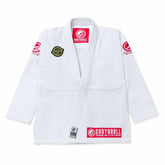IBJJF vs UAEJJF: Key Rule Differences Every BJJ Athlete Should Know (2025 Guide)
Brazilian Jiu-Jitsu (BJJ) continues to expand as one of the most popular martial arts in the world. Its international federations and tournaments set the standard for competition. Among the biggest organizations in BJJ are the International Brazilian Jiu-Jitsu Federation (IBJJF) and the UAE Jiu-Jitsu Federation (UAEJJF). Both aim to promote the sport globally. However, their rule sets differ in several critical ways that every BJJ athlete—whether wearing a Gi or competing No-Gi—must understand.
In this detailed guide, we break down the key differences between IBJJF and UAEJJF rules. Thus, helping athletes and coaches prepare strategically for competition in 2025 and beyond. Understanding these differences can mean the difference between victory and disqualification.
1- Philosophy and Global Presence
IBJJF: Traditional Roots of Brazilian Jiu Jitsu
The IBJJF is widely recognized as the most traditional governing body for Brazilian Jiu-Jitsu. It has deep roots in the sport's Brazilian origins. Most BJJ Gi academies and instructors align their belt promotions and teaching styles with IBJJF standards. Tournaments like the World Jiu-Jitsu Championship (Mundials), Pan Ams, and European Open fall under the IBJJF umbrella.
UAEJJF: Modernization with Global Inclusivity
The UAEJJF, founded by the United Arab Emirates, is known for pushing BJJ toward Olympic inclusion. It offers more professional structure and financial support. It often hosts tournaments like the Abu Dhabi World Pro and Grand Slams across multiple continents. UAEJJF promotes global accessibility by offering prize money even at white and blue belt levels, attracting a diverse athlete pool.
2- Scoring System
IBJJF Scoring System:
- Takedown: 2 points
- Guard pass: 3 points
- Mount: 4 points
- Back control with hooks: 4 points
- Sweep: 2 points
- Knee-on-belly: 2 points
IBJJF’s point system emphasizes positional control. Thus, rewarding athletes who dominate positionally and control the fight.
UAEJJF Scoring System:
UAEJJF uses a slightly modified point system, where advantages are not used. Here is the breakdown:
- Takedown: 2 points
- Guard pass: 3 points
- Mount: 4 points
- Back control with hooks: 4 points
- Sweep: 2 points
- Knee-on-belly: 2 points
Key Difference:
UAEJJF does not use "advantages", whereas IBJJF does. This dramatically changes the strategy of a match. In IBJJF, athletes may win based on advantages even if points are tied. However, UAEJJF demands actual point superiority or submission for victory.
3- Advantages vs Penalties
IBJJF:
- Uses advantages for near-submissions or almost achieving a point-scoring position.
- Also uses penalties for stalling or illegal grips.
UAEJJF:
- No advantages—a more decisive and clear scoring system.
- Penalties are stricter, and negative scores (e.g., for guard pulling or passivity) can be awarded. These negative scores can significantly affect the match outcome.
4- Gi and Uniform Rules
IBJJF Gi Rules:
- Strict Gi measurements and color regulations.
- Patches must be placed according to IBJJF specifications.
- No loose Gis or oversized sleeves.
UAEJJF Gi Rules:
- More lenient with BJJ Gi designs, but still professional.
- Allows modern fabrics and variations, especially in international competitions.
- Uniform checks are still performed but with a bit more flexibility.
Note: Athletes should always check Gi measurements and patch placements before stepping on the mat in either federation.
5- Submission Legality by Belt
IBJJF Submission Guidelines:
- White Belt: No submissions like heel hooks, wrist locks, or reaping.
- Blue-Purple: Limited leg locks allowed, no twisting locks.
- Brown-Black: Can apply toe holds, knee bars, and wrist locks.
No heel hooks allowed in Gi at any level, only recently legalized in No-Gi for brown and black belts.
UAEJJF Submission Guidelines:
- Slightly more liberal for higher belts.
- Heel hooks are still illegal in Gi but allowed in some No-Gi advanced divisions.
- Emphasizes athlete safety but allows more technical creativity.
6- Match Duration
| Belt Rank | IBJJF Gi Match Time | UAEJJF Gi Match Time |
|---|---|---|
| White | 5 minutes | 4 minutes |
| Blue | 6 minutes | 5 minutes |
| Purple | 7 minutes | 6 minutes |
| Brown | 8 minutes | 6 minutes |
| Black (Adult) | 10 minutes | 6 minutes |
UAEJJF matches are shorter, encouraging faster-paced action and less stalling. IBJJF allows more time for technical control and positional play.
7- Guard Pulling and Penalties
IBJJF:
- Guard pulling is allowed with no penalty.
- Encourages tactical battles from bottom players.
UAEJJF:
- Pulling guard gives a -1 penalty in many divisions.
- Pushes athletes to initiate takedowns, making matches more wrestling-centric.
This one change significantly affects how many BJJ athletes, especially lightweights and guard players, strategize in UAEJJF competitions.
8- Weigh-In Rules
IBJJF:
- Weigh-in is done with the Gi on immediately before the match.
- No allowance is given for extra weight.
UAEJJF:
- Weigh-ins can be with or without Gi, depending on the event.
- Done a day before or a few hours prior to matches.
- More time to rehydrate and prepare for performance.
This makes UAEJJF more lenient for weight-cutting athletes. Thus, allowing for better recovery before competition.
9- Ranking and Prize Structure
IBJJF:
- Points system for world ranking.
- Most tournaments offer medals and some sponsorship exposure.
- No prize money at most tournaments unless it’s a special pro event.
UAEJJF:
- Robust global ranking system.
- Cash prizes awarded even at white, blue, and purple belts.
- Monthly Grand Slams and World Pro with thousands of dollars in rewards.
- Encourages professionalization of athletes.
For aspiring professional BJJ athletes, the UAEJJF is a rewarding option.
10- Women’s Participation and Belt Rules
Both federations encourage equal participation of women in BJJ. However, UAEJJF mandates earlier belt progression for youth and females under specific criteria. This promotes wider growth. However, IBJJF follows more traditional belt timelines.
Which Federation Is Better for You?
The choice between IBJJF and UAEJJF depends on your style, goals, and values in Brazilian Jiu Jitsu.
Choose IBJJF if:
- You prefer traditional BJJ rules and longer matches.
- You are focused on technical, positional BJJ.
- You train at an academy aligned with IBJJF belt rankings.
- You are looking to compete at Worlds, Pans, or Euros.
Choose UAEJJF if:
- You want to earn prize money while competing.
- You prefer faster-paced matches and no advantage scoring.
- You excel in takedowns and aggressive transitions.
- You are aiming for professional BJJ recognition and global rankings.
Final Thoughts
As Brazilian Jiu Jitsu evolves in 2025, knowing the key rule differences between IBJJF and UAEJJF is critical. It does not matter if you are wearing your BJJ Gi on the world stage in Abu Dhabi or competing in Los Angeles. Your strategy, grips, submissions, and mindset must align with the ruleset in place.
Success in modern BJJ is no longer just about technique. But it is about preparation, adaptability, and knowing the battlefield.
So, study the rules, train smart, and dominate the mat—no matter which federation you choose.
Want to compete like a pro? Equip yourself with premium BJJ Gi and gear at Novakik BJJ. From IBJJF-legal Gis to No-Gi rash guards and competition kits, we have got everything you need to win.







